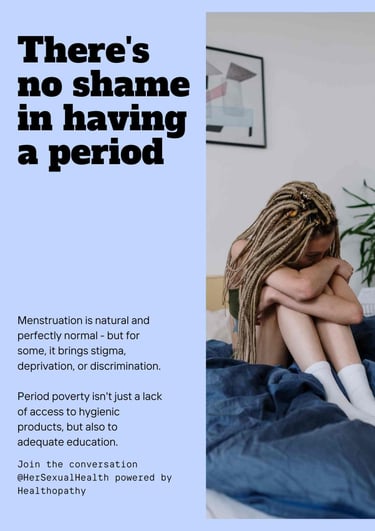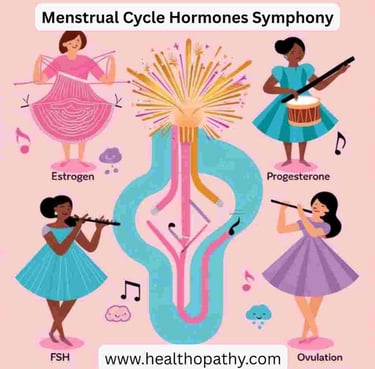🩸 Is Your Period Actually Normal? Let’s Break It Down
Not all periods are created equal. This expert-backed guide breaks down what a normal menstrual cycle really looks like — from flow and frequency to pain and color. With visual charts, hormone insights, and lifestyle tips, you’ll learn to spot red flags and understand your body better. Empower yourself with knowledge and track your cycle like a pro. Perfect for teens, women, and anyone seeking menstrual clarity. ✅ Includes a downloadable period tracker ✅ Doctor-informed normal vs abnormal comparisons ✅ Ideal for cycle education, self-care, and health awareness
HERSEXUALHEALTH
Periods are a natural part of life, yet so many myths and uncertainties can leave us feeling adrift each month. From the first time you start bleeding as a teenager to the shifts your body experiences in your forties, understanding the signs of a healthy cycle gives you the power to advocate for your own well-being. By knowing what falls within the typical range—and when to reach out for help—you’ll gain confidence and clarity every time your period arrives.
So, what does a textbook period look like? Most people have cycles that span between 21 and 35 days, counted from the first day of one bleed to the first day of the next. During that window, you’re likely to bleed for 3 to 7 days, losing roughly 30 to 80 milliliters of blood (about 2 to 6 tablespoons). The hue can vary—bright red, deep red, or even brown toward the end—and mild to moderate cramps that respond to over-the-counter pain relief are common. If you consistently fall outside these patterns—bleeding for fewer than 2 or more than 8 days, cycling under 21 or over 35 days, passing large clots, soaking through products hourly, noticing gray or pitch-black blood, or experiencing debilitating pain—it’s wise to consult a healthcare provider. Your period is your body’s barometer; pay attention to its signal and take charge of your health.


📊 Common Period Patterns (and What They Might Mean)
1. Heavy Periods (Menorrhagia)
You may have menorrhagia if you're:
Changing pads/tampons every hour
Passing clots larger than a quarter
Bleeding longer than 7 days
Possible Causes: Hormonal imbalance, fibroids, thyroid issues, or blood clotting disorders.
Track it: Use a period tracking app to measure how often you change products. If it’s overwhelming your life, it’s time to talk to a doctor.
2. Irregular Cycles
Missed a few periods or can’t predict when it’s coming?
Possible Causes: PCOS, stress, extreme exercise, under-eating, or early signs of perimenopause.
Important terms to know:
Oligomenorrhea: Infrequent periods (>35 days apart)
Amenorrhea: No period for 3+ months (not pregnant or menopausal)
3. Painful Periods (Dysmenorrhea)
Cramps are common, but if you're curled up for days or skipping school/work, it's not just "normal cramps."
Possible Causes: Endometriosis, adenomyosis, pelvic inflammatory disease, or IUD side effects.
🧬 Hormones and Your Flow: What's Really Going On?
Your period is controlled by the dance of four key hormones:
Estrogen: Thickens the uterine lining
Progesterone: Stabilizes the lining
LH (Luteinizing Hormone): Triggers ovulation
FSH (Follicle Stimulating Hormone): Stimulates egg maturation
A healthy cycle requires all four in harmony. When one is out of balance, irregular periods, mood swings, or acne can show up.
Hormonal Imbalance Signs: Irregular periods, mood instability, breast tenderness, hair loss, acne, unexplained weight gain or loss.


🥗 Diet, Stress & Lifestyle: Yes, They Affect Your Period
High stress = missed or delayed periods
Low-carb or extreme dieting = hormone disruption
Too much or too little exercise = irregular or absent periods
Lack of sleep = PMS intensification
Support Your Cycle With:
Iron-rich foods (leafy greens, lentils, red meat) after bleeding
Magnesium (helps with cramps – think dark chocolate, seeds)
Omega-3s (reduces inflammation and period pain)
Sleep & stress management
🚩 When to See a Doctor
You should speak to a healthcare provider if you experience:
Periods <21 or >35 days apart consistently
Bleeding >7 days
Clots larger than a grape
Severe cramps not relieved by OTC meds
Missed periods (and you're not pregnant)
Sudden changes in your cycle or PMS intensity
Don’t dismiss these signs. Period issues can be a window into reproductive or general health.
